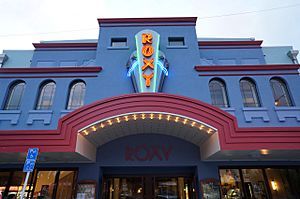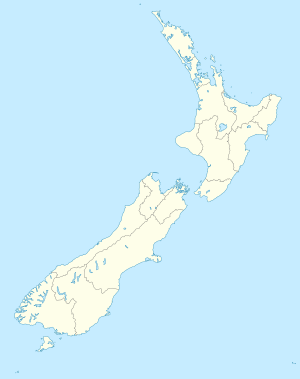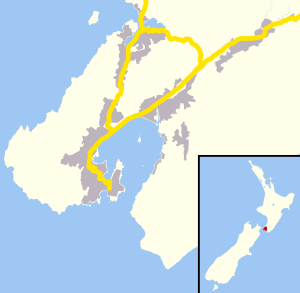Miramar, New Zealand facts for kids
Quick facts for kids
Miramar
|
|
|---|---|
|
Suburb
|
|

Roxy Cinema in Miramar
|
|
| Country | New Zealand |
| Local authority | Wellington City |
| Electoral ward |
|
| Established | 1904 |
| Area | |
| • Land | 287 ha (709 acre) |
| Population
(June 2023)
|
|
| • Total | 10,030 |
|
|
||
Miramar is a suburb of Wellington, New Zealand, south-east of the city centre. It is on the Miramar Peninsula, directly east of the isthmus of Rongotai, the site of Wellington International Airport.
Contents
History
Miramar Peninsula was originally an island, separated from Kilbirnie by a sea channel called Te Awa-a-Taia (the channel of Taia); this was where the Rongotai isthmus is now. The original Māori name for the whole area when it was still an island was Te Motu Kairangi (meaning "esteemed" or "precious" island).
'Miramar' means 'sea view' in Spanish. The name was chosen by the first European to settle in the area, Scotsman Coutts Crawford (1817–1889). Crawford was a former Royal Navy officer turned businessman and colonist, who arrived in Wellington in 1840. Crawford established a farm on Miramar Peninsula, which at the time was known as Watt's Peninsula, and drained a large lagoon known as Burnham Water. This lagoon covered much of the low-lying land on the peninsula; now this area is occupied by suburban houses, streets, parks and shops in the suburb of Miramar.
On 18 November 1904 Miramar Borough was formed. In April 1921, Miramar was incorporated into the City of Wellington. The records of the Miramar Borough Council were transferred to the City of Wellington at the time of amalgamation and can still be accessed today through Wellington City Council.
Location
As of 2024, the suburb of Miramar consists of the mainly-flat central basin of Miramar Peninsula, separated from surrounding suburbs from the northwest around to the east by a ring of hills. In the northwest and north, Miramar's boundary with Maupuia lies roughly along the ridgeline, and to the east Nevay Road and Seatoun Heights Road separate Miramar from Karaka Bays and Seatoun. In the flatter west and south, Miramar is bounded by Calabar Road and Wellington Airport to the west and by Broadway and Strathmore Park to the south.
Demographics
Miramar, comprising the statistical areas of Miramar North, Miramar Central, Miramar East and Miramar South, covers 2.87 km2 (1.11 sq mi). It had an estimated population of 10030 as of June 2023, with a population density of 3495 people per km2.
| Historical population | ||
|---|---|---|
| Year | Pop. | ±% p.a. |
| 2006 | 9,210 | — |
| 2013 | 9,486 | +0.42% |
| 2018 | 9,831 | +0.72% |
Before the 2023 census, Miramar had a slightly different boundary, covering 2.87 km2 (1.11 sq mi). Using that boundary, Miramar had a population of 9,831 at the 2018 New Zealand census, an increase of 345 people (3.6%) since the 2013 census, and an increase of 621 people (6.7%) since the 2006 census. There were 3,585 households, comprising 4,851 males and 4,989 females, giving a sex ratio of 0.97 males per female, with 1,881 people (19.1%) aged under 15 years, 1,770 (18.0%) aged 15 to 29, 4,794 (48.8%) aged 30 to 64, and 1,389 (14.1%) aged 65 or older.
Ethnicities were 66.6% European/Pākehā, 8.6% Māori, 9.3% Pasifika, 20.7% Asian, and 6.3% other ethnicities. People may identify with more than one ethnicity.
The percentage of people born overseas was 32.9, compared with 27.1% nationally.
Although some people chose not to answer the census's question about religious affiliation, 44.6% had no religion, 37.4% were Christian, 0.4% had Māori religious beliefs, 5.7% were Hindu, 1.4% were Muslim, 2.8% were Buddhist and 1.8% had other religions.
Of those at least 15 years old, 2,475 (31.1%) people had a bachelor's or higher degree, and 1,206 (15.2%) people had no formal qualifications. 1,938 people (24.4%) earned over $70,000 compared to 17.2% nationally. The employment status of those at least 15 was that 4,302 (54.1%) people were employed full-time, 1,071 (13.5%) were part-time, and 282 (3.5%) were unemployed.
| Name | Area (km2) |
Population | Density (per km2) |
Households | Median age | Median income |
|---|---|---|---|---|---|---|
| Miramar North | 0.51 | 1,347 | 2,641 | 465 | 36.8 years | $34,000 |
| Miramar Central | 0.53 | 1,971 | 3,719 | 783 | 39.8 years | $32,300 |
| Miramar East | 0.85 | 3,003 | 3,533 | 1,080 | 38.9 years | $47,300 |
| Miramar South | 0.98 | 3,510 | 3,582 | 1,257 | 38.1 years | $36,600 |
| New Zealand | 37.4 years | $31,800 |
Film
Prior to World War II in 1936 the then government purchased an independent film company called Filmcraft in Darlington Rd, Miramar and set up a full body, government film production operation, to cover New Zealand's contribution in the war (and the 1940 Centennial celebrations). It was called the National Film Unit. In 1979 the NFU moved to Avalon, Lower Hutt, next to the national television entity Avalon Studios. In the late nineties, film director Sir Peter Jackson purchased the Film Unit, as it was then known, to produce his films. He used the NFU's facilities while making Braindead. Since then, Jackson has brought the Film Unit back to Miramar, which would now be seen as a sunset arm of his empire.
Jackson and his colleagues Sir Richard Taylor (VFX) and Jamie Selkirk (Editor) have built a series of multi million-dollar studios, sound stages, and pre- and post-production facilities in Miramar that include Stone Street Studios, Park Road Post, Weta Digital, and Weta Workshop. Jackson filmed the studio scenes of The Lord of the Rings trilogy and King Kong in Miramar. Miramar has been hailed by Mexican film director Guillermo del Toro as "Hollywood the way God intended it".
Roxy Cinema
The Roxy Cinema building at the Miramar shopping centre in Park Road was built by local businessman Sidney Morrison, and opened as Capitol Theatre in January 1929. The Capitol closed in 1964 and the building then became the Capitol Court shopping plaza. After lying abandoned for many years, the building was bought by Camperdown Studios Group in 2003. The façade was retained but the rest of the building was demolished and rebuilt as a two-screen movie theatre, opening in 2011. As of 2022 the Roxy was owned by Jamie Selkirk and his wife Ann, Weta Workshop founder Tania Rodger, local foodie Valentina Dias, Daminda Dias, and renowned bartender and cocktail master Ray Letoa. The interior of the building is designed in a lush 1930s style. The upstairs lobby features a large ceiling mural by Greg Broadmore of Weta Workshop, which was inspired by the film Metropolis. An Oscar won by Jamie Selkirk was on display in the theatre, and a statue of Gandalf stands in front of the building.
Education
Early Childhood Education
There are a number of early childhood educational facilities in Miramar, including Miramar North Kindergarten, Miramar Central Kindergarten, Tuatara Kids, Kidz Corner, and Montessori Children's House.
Primary schools
Miramar Central School is a co-educational state primary school for Year 1 to 6 students, with a roll of 165 as of February 2024.
Miramar North School is also a co-educational state primary school for Year 1 to 6 students, with a roll of 248.
Year 7 and 8 students from Miramar typically attend Evans Bay Intermediate School in Kilbirnie.
Holy Cross School is a co-educational state-integrated Catholic primary school for Year 1 to 8 students, with a roll of 155 in 2022.
Miramar Christian School, a co-educational state-integrated Christianity-based primary school for Year 1 to 8 students, was established in Miramar in 1979. From 2025 it moved to Johnsonville and the name was changed to Wellington Hills Christian College.
Miramar South School was a former state primary school in the south of the suburb. It opened in 1922 and closed in 2012, when it merged with Strathmore Community School at their site in Strathmore Park to form Kahurangi School.
Secondary schools
Secondary students in Miramar are within the school enrolment zones of the state secondary schools Wellington East Girls' College (single-sex, girls) in Mount Victoria, Rongotai College (single-sex, boys) in Rongotai, and Wellington High School (co-educational) in Mount Cook.



